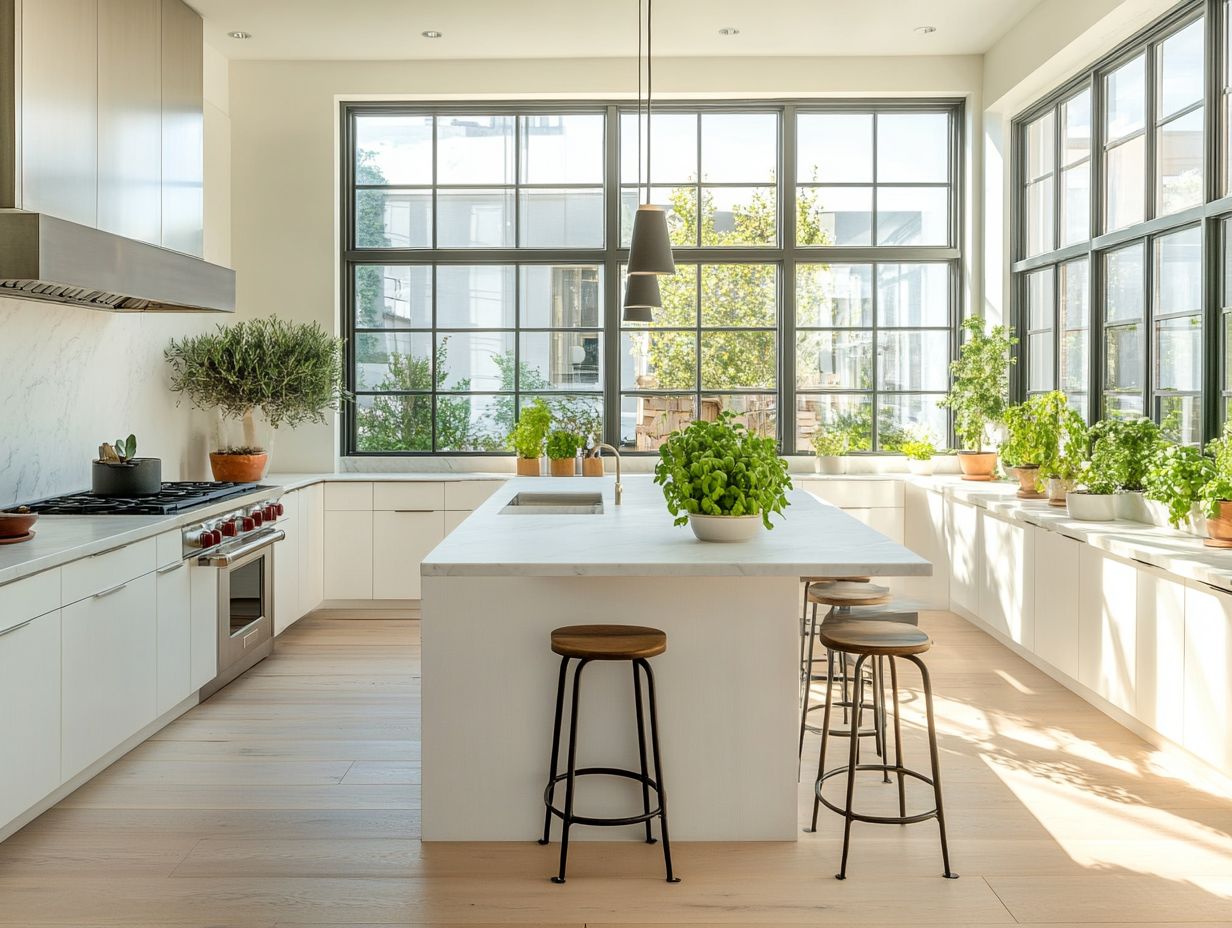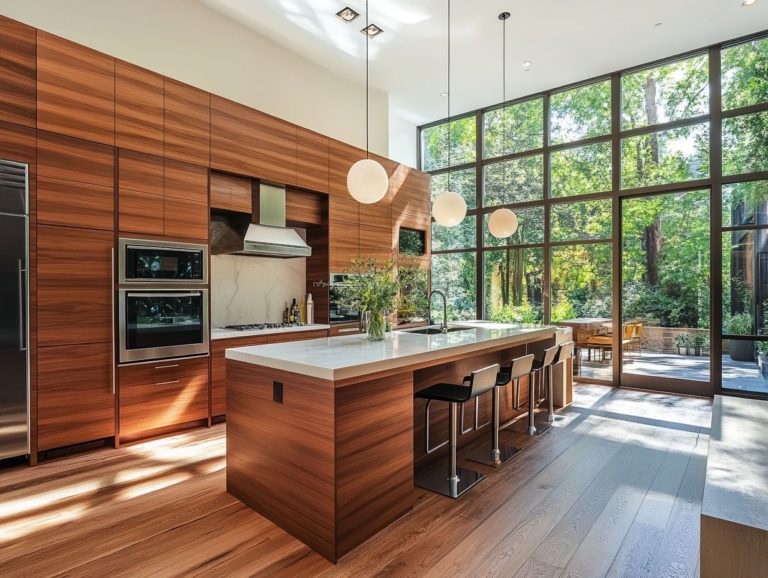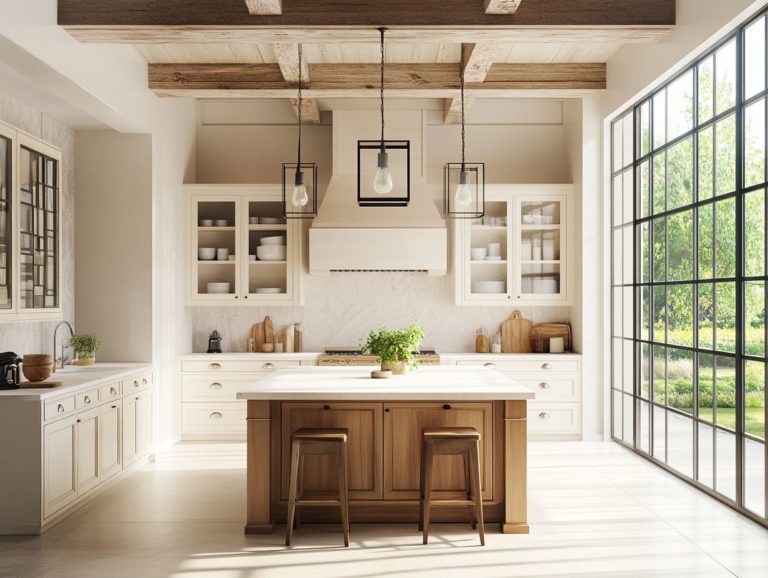Transforming Your Kitchen: Layout Inspiration
Your kitchen is more than just a place for cooking; it’s the very heart of your home. Selecting the right layout can enhance functionality, improve flow, and elevate your overall culinary experience.
This article delves into various kitchen layouts, from galley to open concept, while discussing essential factors like size and functionality that will influence your choices.
Get ready to discover invaluable tips and ideas that will help you craft your dream kitchen space!
Dive in and discover the perfect layout inspiration for your culinary haven!
Contents
- Key Takeaways:
- Understanding Kitchen Layouts
- Factors to Consider When Choosing a Layout
- Popular Kitchen Layouts
- Designing Your Dream Kitchen
- Transforming Your Kitchen on a Budget
- Preguntas Frecuentes
- ¿Cuáles son algunos consejos para transformar el diseño de mi cocina?
- ¿Cuáles son algunas opciones comunes de diseño de cocinas?
- ¿Cómo puedo incorporar un diseño de concepto abierto en el diseño de mi cocina?
- ¿Qué tan importante es considerar mi presupuesto al planificar un cambio en el diseño de la cocina?
- ¿Cuáles son algunas tendencias de diseño populares para las cocinas?
- ¿Cómo puedo asegurarme de que mi nuevo diseño de cocina satisfaga mis necesidades específicas?
Key Takeaways:

Understand the different types of kitchen layouts to determine which one best suits your needs and space.
Consider factors such as size, shape, functionality, and flow when choosing a layout for your kitchen.
Some popular kitchen layouts include galley, L-shaped, U-shaped, and open concept, each with its own benefits and considerations.
Understanding Kitchen Layouts
Understanding kitchen layouts is vital for crafting a space that is both visually appealing and highly functional. With many designs and layout ideas available, you have the opportunity to elevate your kitchen’s ambiance while optimizing workflow and storage solutions.
From the ideal distance between the stove, sink, and refrigerator for efficient cooking to sleek modern designs, each option caters to unique needs and preferences. It’s essential to identify the ideal fit for your culinary haven.
Whether envisioning a cozy family kitchen or a spacious open-plan design, grasping the fundamentals of kitchen layouts will undoubtedly simplify your renovation journey.
Types of Kitchen Layouts
There are several types of kitchen layouts, each offering unique advantages tailored to different cooking styles and home designs. Whether you opt for the space-saving galley kitchen or the versatile U-shaped design, you have the opportunity to select a layout that meets your functional needs while enhancing the overall aesthetics of your culinary space.
Layout options also include the ever-popular open-plan kitchen that seamlessly integrates dining areas, as well as the L-shaped design that provides ample cabinetry for effective storage. Knowing these layouts helps you optimize your kitchen’s functionality and efficiency.
By choosing the right kitchen design, you can truly customize your cooking environment. For instance, a galley kitchen’s narrow pathway allows for efficient movement between appliances, though it may limit your storage and counter space.
On the other hand, the U-shaped layout encourages interaction and multitasking, although it can overwhelm smaller homes. The open-plan design is perfect for social gatherings, yet it requires careful planning to maintain a cohesive look with adjacent spaces.
Each layout influences how you navigate the kitchen, organize your tools, and ultimately shapes your culinary experience, highlighting the significant role that design plays in your daily routines.
Factors to Consider When Choosing a Layout
When selecting a kitchen layout, several essential factors demand your attention, including the size and shape of the space, as well as its functionality and flow.
Grasping the spatial dimensions and envisioning how the kitchen will serve your needs can profoundly impact the design process. A thoughtfully planned layout not only boosts efficiency but also ensures the kitchen feels both comfortable and inviting.
It’s vital for you to think about how the layout will accommodate storage solutions, appliance placement, and the overall ambiance. This helps you build a kitchen that feels just right for your everyday life!
Now that you understand the different kitchen layouts, it’s time to take the next step. Start planning your perfect kitchen today!
Size and Shape of Kitchen
The size and shape of your kitchen are crucial factors in determining the most suitable layout for your cooking and dining needs. Whether you’re working with a spacious kitchen that can accommodate an impressive double island layout or a cozy space that demands clever, space-saving designs, grasping these dimensions is vital.
The shape—whether L-shaped, U-shaped, or galley—directly influences how efficiently you navigate your kitchen. This ultimately affects your overall cooking experience.
For instance, in a compact galley kitchen, you can maximize vertical space with open shelves. This creates an illusion of openness while boosting storage. In a larger U-shaped kitchen, a central island can serve multiple roles, such as a meal prep area, a dining spot, or even a gathering hub! Each layout offers unique opportunities to optimize workflow and accessibility.
By tailoring the design to fit these specific characteristics, you enhance functionality and create a delightful environment for both cooking and socializing.
Functionality and Flow

Functionality and flow are essential in your kitchen design! They determine how efficiently you can use the space for both cooking and entertaining. A well-designed kitchen should facilitate smooth movement between different areas, adhering to the principles of the kitchen triangle—the arrangement of the sink, stove, and refrigerator to enhance your workflow.
By placing appliances and workstations strategically, you can create a harmonious kitchen workspace that effortlessly accommodates everyday cooking and social gatherings. Understanding the significance of this layout ensures that tasks like prepping, cooking, and cleaning are seamlessly interconnected.
The kitchen triangle minimizes unnecessary steps and maximizes your efficiency. To achieve an optimal kitchen layout, think about where to place islands or countertops to provide additional workspace while maintaining clear paths.
Incorporate ample storage solutions to reduce clutter! This makes it easier for you to navigate while cooking. Use creative lighting to enhance functionality and ambiance, ensuring that every corner of your kitchen remains inviting—whether you’re enjoying a quiet weekday meal or hosting a lively family gathering.
Popular Kitchen Layouts
Popular kitchen layouts have transformed over the years, shaped by evolving lifestyles and design trends. Consider the efficient galley kitchen, which brilliantly maximizes space in smaller homes, or the inviting open-concept design that fosters social interaction.
Each layout serves a unique purpose. The L-shaped and U-shaped kitchens are perennial favorites, celebrated for their versatility and abundant cabinetry. Emerging trends continually redefine modern kitchen aesthetics!
By grasping these popular layouts, you’ll be better equipped to choose the perfect one for your home renovation and design journey. Why not start planning your ideal kitchen design today?
Galley Kitchen
The galley kitchen stands out as an incredibly efficient layout! It features two parallel countertops that create a narrow corridor for movement. Imagine maximizing your storage options with this incredible space-saving design, making it perfect for small kitchens or homes where every square foot counts.
Despite its compact nature, a galley kitchen can be both functional and stylish, providing a streamlined cooking experience without compromising on aesthetics.
One of the key advantages of this configuration is its optimized workflow, often referred to as the classic ‘kitchen triangle.’ The stove, sink, and refrigerator are conveniently within reach. However, the narrowness can present challenges, especially when more than one person is trying to cook or navigate the space simultaneously.
To tackle these potential hurdles, consider incorporating smart storage solutions such as:
- Shelving
- Cabinets that stretch to the ceiling
- Pull-out pantry sections
Use creative lighting—think under-cabinet lights or reflective surfaces—to transform the atmosphere! This makes the galley kitchen not just a workspace but a stunning heart of your home.
L-Shaped Kitchen
The L-shaped kitchen layout stands out for its remarkable versatility. It features two adjoining walls that create a seamless triangle among your cooking, cleaning, and refrigeration areas.
This design facilitates efficient movement and offers generous cabinetry for all your storage needs.
That open corner? It’s perfect for adding a cozy dining nook or extra workspace, making the L-shaped kitchen an ideal choice for families who relish cooking and entertaining.
Its adaptable nature allows you to explore various design options, tailoring the space to suit your unique requirements. For example, adding an island or a breakfast bar can significantly enhance functionality while encouraging family gatherings.
To truly optimize this layout in your family kitchen, think about a combination of open shelves and closed cabinets. This approach ensures that your frequently used items are easily accessible while keeping the space looking tidy.
By utilizing vertical space with high cabinets or shelving, you can maximize storage without encroaching on precious floor area, making the L-shaped kitchen both practical and inviting.
U-Shaped Kitchen
The U-shaped kitchen layout is crafted with three walls of cabinetry and appliances, creating a spacious and functional cooking area. This design beautifully supports the kitchen triangle, facilitating effortless movement between the stove, sink, and refrigerator.
With generous counter space and ample storage options, the U-shaped kitchen is perfect for anyone who values additional workspace and a well-organized environment.
Every square inch is optimized for efficient use, ensuring that your cooking essentials are always within arm’s reach.
To enhance storage, consider incorporating tall cabinets that maximize vertical space for items often relegated to the back of cupboards.
Utilizing corner cabinets equipped with lazy susans—rotating trays that help access corner cabinet items easily—offers practical solutions for accessing those tricky, overlooked areas.
Blending open shelving with closed cabinetry not only boosts accessibility but also allows you to express your personal style through decorative displays.
By streamlining workflow and enhancing organization, this layout significantly elevates kitchen efficiency, inviting your culinary creativity and simplifying preparation.
Open Concept Kitchen

The open concept kitchen embodies a modern design trend that seamlessly merges the cooking area with dining and living spaces, crafting a social layout that encourages interaction among family and guests.
This approach elevates kitchen aesthetics and fosters a sense of spaciousness, allowing natural light to flow freely throughout your home. By removing barriers, the open concept kitchen creates an inviting atmosphere, making it a favored choice for contemporary residences.
In this setup, it transforms into the central hub where everyone gathers, shares stories, and participates in meal preparations, enriching your overall living experience.
While this layout offers countless advantages, it does come with its challenges, such as noise and clutter. To tackle these issues, maintaining organization becomes essential.
Embrace clever storage solutions like pull-out shelves and multi-functional furniture to keep your space tidy and functional.
Create dedicated zones for cooking and dining to enhance both practicality and enjoyment, ensuring that this modern design remains efficient and enjoyable.
Designing Your Dream Kitchen
Designing your dream kitchen requires meticulous planning and thoughtful consideration of various features that elevate both aesthetics and functionality.
You’ll want to focus on selecting the ideal cabinetry and integrating modern kitchen innovations that align seamlessly with your lifestyle and cooking habits.
By drawing inspiration from current trends and timeless elements, you can craft a cohesive kitchen that fulfills all your needs, turning the renovation journey into an exciting and rewarding experience.
Start planning your dream kitchen today and transform your space into a culinary haven!
Tips for Creating Your Ideal Layout
Creating your ideal kitchen layout requires careful thought about organization and appliance placement.
Focus on essential features that match your cooking style for a functional and flowing workspace.
Use space-saving designs and organization strategies to make your kitchen efficient, transforming it into the dream space you’ve always envisioned.
To achieve this, visualize the work triangle, where the stove, sink, and refrigerator are placed in a triangular layout to make cooking easier.
Embrace vertical storage solutions like shelving and hanging racks to free up valuable counter space, ensuring that your most-used tools are always at your fingertips.
Consider adding a kitchen island for extra prep space. It can also serve as a social hub for family and friends to gather.
Arrange your appliances to promote a natural workflow, making it easy to transition seamlessly from one cooking task to the next.
Transforming Your Kitchen on a Budget
Transforming your kitchen on a budget doesn’t require you to compromise on style or functionality.
With a thoughtful approach, you can discover affordable design ideas that result in a breathtaking kitchen makeover.
From straightforward renovations to savvy updates, you can elevate your space without straining your finances.
Embrace creative solutions, like repurposing cabinetry or choosing cost-effective materials, to rejuvenate your kitchen.
This ensures it remains both stunning and functional.
Affordable Design Ideas and Solutions
Affordable design ideas and solutions can truly transform your kitchen renovation without straining your budget.
Simple DIY projects, like painting cabinets or swapping out fixtures, can make a dramatic difference in the space.
Opt for budget-friendly countertops and flooring to enhance style and boost durability.
By concentrating on strategic updates, you can create a modern kitchen that genuinely reflects your taste and lifestyle.
Get creative! Use wall art and smart storage solutions to transform neglected corners into functional and stylish spaces.
Upgrading hardware, such as knobs and pulls, offers another quick and cost-effective way to elevate the overall aesthetic.
Preguntas Frecuentes

¿Cuáles son algunos consejos para transformar el diseño de mi cocina?
1. Considera la funcionalidad de tu cocina: Piensa en cómo usas tu cocina y qué cambios mejorarían su funcionalidad.
2. Planifica para tus necesidades: Asegúrate de que tu nuevo diseño tenga suficiente espacio y almacenamiento para tus necesidades diarias.
3. Utiliza todo el espacio disponible: No tengas miedo de ser creativo y utilizar rincones o espacios incómodos en tu diseño.
4. Ten en cuenta el triángulo de trabajo: El fregadero, la estufa y el refrigerador deben formar un triángulo para un uso eficiente.
5. No pases por alto la iluminación: Una buena iluminación puede hacer una gran diferencia en el aspecto y la sensación general de tu cocina.
6. Considera el flujo: Asegúrate de que tu nuevo diseño permita un movimiento y flujo de tráfico fáciles en la cocina.
¿Cuáles son algunas opciones comunes de diseño de cocinas?
1. En forma de L: Este diseño popular cuenta con dos paredes adyacentes en un ángulo recto con un espacio abierto para un área de comedor o sala.
2. En forma de U: En este diseño, la cocina está rodeada por tres paredes, proporcionando amplio espacio de mostrador y almacenamiento.
3. Pasillo: También conocido como diseño de corredor, este diseño presenta dos paredes paralelas con un pasillo en el medio.
4. Isla: Una isla puede servir como un punto focal y agregar espacio extra de mostrador y almacenamiento a cualquier diseño.
5. Una pared: Este diseño es perfecto para espacios pequeños y cuenta con una línea recta de gabinetes y electrodomésticos a lo largo de una pared.
6. Península: Similar a una isla, una península está unida a una pared y proporciona espacio adicional de mostrador y almacenamiento.
¿Cómo puedo incorporar un diseño de concepto abierto en el diseño de mi cocina?
1. Elimina paredes: Considera quitar paredes entre la cocina y el comedor para crear un espacio más amplio.
2. Usa una isla o península: Estas características ayudan a definir el espacio de la cocina mientras se mantiene un ambiente abierto.
3. Elige colores claros: Los colores claros hacen que el espacio se sienta más aireado.
4. Opta por estanterías abiertas: En lugar de gabinetes superiores, elige estanterías abiertas para un aspecto acogedor.
5. Usa luz natural: Agrega ventanas o tragaluces para maximizar la luz en el espacio.
6. Mantén el espacio libre de desorden: Un diseño abierto brilla más en un espacio limpio y ordenado.
¿Qué tan importante es considerar mi presupuesto al planificar un cambio en el diseño de la cocina?
Tu presupuesto es fundamental para hacer realidad tu cocina soñada. Te ayuda a priorizar tus necesidades y a decidir qué cambios son posibles.
No olvides considerar los costos de mano de obra, materiales y permisos.
¿Cuáles son algunas tendencias de diseño populares para las cocinas?
1. Minimalismo: Un diseño limpio y simple con líneas elegantes.
2. Mezcla de materiales: Combina madera, metal y piedra para un aspecto único.
3. Colores contrastantes: Usa colores diferentes para gabinetes y encimeras para hacer una declaración audaz.
4. Islas multifuncionales: Espacios que sirven como área de trabajo y comedor.
5. Almacenamiento oculto: Soluciones de almacenamiento para un aspecto ordenado.
6. Iluminación llamativa: Accesorios de iluminación que aportan personalidad y estilo.
¿Cómo puedo asegurarme de que mi nuevo diseño de cocina satisfaga mis necesidades específicas?
1. Consulta con un profesional: Un diseñador de cocina puede ayudarte a crear un diseño a medida.
2. Crea una lista de deseos: Enumera las características que son importantes para ti.
3. Investiga y reúne inspiración: Busca ideas en línea o en revistas.
4. Considera tu rutina diaria: Diseña tu cocina para que sea más eficiente en tu día a día.
5. Prueba el diseño: Visualiza el diseño antes de finalizarlo para asegurarte de que funcione para ti.





